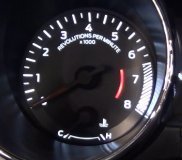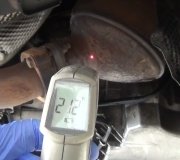I would think that the harsh shift is typical, one of the characteristics of limp home may be maximum transmission line pressure. The T/C light is also a result. P0122 and P0222 are throttle position sensor 1 and 2 faults. It could be a faulty connection at the throttle body, a faulty throttle body, or the circuits from the ecm to the throttle body. I will include the dtc chart for p0122, it also makes reference in one of the steps, as to whether p0222 is also set, so it sounds like you have a hard failure. In contrast, an intermittent failure would be a bit more difficult to trace.
DTC P0122
Circuit Description
The throttle body assembly contains 2 throttle position (TP) sensors. The TP sensors are mounted to the throttle body assembly and are not serviceable. The TP sensors provide a signal voltage that changes relative to throttle blade angle. The engine control module (ECM) supplies the TP sensors with a common 5-volt reference circuit, a common low reference circuit, and 2 independent signal circuits.
The TP sensors have opposite functionality. TP sensor 1 signal voltage increases from below 1 volt at idle to above 4 volts at wide open throttle (WOT). TP sensor 2 signal voltage decreases from above 4 volts at idle to below 1 volt at WOT.
If the ECM detects TP sensor 1 signal voltage is too low, this DTC sets.
DTC Descriptor
This diagnostic procedure supports the following DTC:
DTC P0122 Throttle Position (TP) Sensor 1 Circuit Low Voltage
Conditions for Running the DTC
"Â The ignition is ON, with the engine OFF, or the engine is operating.
"Â The ignition 1 voltage is more than 7 volts.
"Â DTC P0122 runs continuously once the above conditions are met.
Conditions for Setting the DTC
The ECM detects the TP sensor 1 signal voltage is less than 0.18 volts for more than 4 second.
Action Taken When the DTC Sets
"Â The control module illuminates the malfunction indicator lamp (MIL) on the second consecutive ignition cycle that the diagnostic runs and fails.
"Â The control module records the operating conditions at the time the diagnostic fails. The first time the diagnostic fails, the control module stores this information in the Failure Records. If the diagnostic reports a failure on the second consecutive ignition cycle, the control module records the operating conditions at the time of the failure. The control module writes the operating conditions to the Freeze Frame and updates the Failure Records.
Conditions for Clearing the MIL/DTC
"Â The control module turns OFF the malfunction indicator lamp (MIL) after 4 consecutive ignition cycles that the diagnostic runs and does not fail.
"Â A current DTC, Last Test Failed, clears when the diagnostic runs and passes.
"Â A history DTC clears after 40 consecutive warm-up cycles, if no failures are reported by this or any other emission related diagnostic.
"Â Clear the MIL and the DTC with a scan tool.
Diagnostic Aids
"Â Use the J 35616-A/BT-8637 Connector Test Adapter Kit for any test that requires probing the ECM harness connector or a component harness connector.
"Â The lower connector of the ECM is connector C1 and the upper connector of the ECM is connector C2. Refer to Engine Controls Component Views.
"Â If there is a condition with the TP sensors, the ECM defaults to reduced power mode for the entire ignition cycle, even if the condition is corrected.
"Â For an intermittent condition, refer to Intermittent Conditions.
Test Description
The numbers below refer to the step numbers on the diagnostic table.
This step verifies that a condition exists.
The TP sensors share a 5-volt reference circuit. If both DTCs P0122 and P0222 set, test for a condition in the 5-volt reference circuit.
The ECM produces a measurable steady-state amperage that provides the 5-volt reference to the TP sensors. If the amperage on the 5-volt reference circuit is less than 50 mA, test the 5-volt reference circuit for an open or a high resistance.
This step tests the signal 1 circuit of the TP sensor. If the TP sensor 1 voltage parameter is not 4.8-5.2 volts, test for a condition in the signal 1 circuit.
Step
Action
Values
Yes
No
Schematic Reference: Engine Controls Schematics
Connector End View Reference: Engine Control Module Connector End Views or Engine Controls Connector End Views
1
Did you perform the Diagnostic System Check - Vehicle?
--
Go to Step 2
Go to Diagnostic System Check - Vehicle
2
Turn ON the ignition, with the engine OFF.
Observe the TP sensor 1 voltage parameter with a scan tool.
Is the voltage less than the specified value?
0.18 V
Go to Step 4
Go to Step 3
3
Observe the Freeze Frame/Failure Records for this DTC.
Turn OFF the ignition for 30 seconds.
Start the engine.
Operate the vehicle within the Conditions for Running the DTC. You may also operate the vehicle within the conditions that you observed from the Freeze Frame/Failure Records.
Did the DTC fail this ignition?
--
Go to Step 4
Go to Diagnostic Aids
4
Observe the DTC information with a scan tool.
Did DTC P0222 also set?
--
Go to Step 5
Go to Step 6
5
Turn OFF the ignition.
Notice: Refer to Disengaging Connectors Notice in the Preface section.
Disconnect the throttle body harness connector. Refer to Throttle Body Assembly Replacement.
Turn ON the ignition, with the engine OFF.
Set up a DMM to test amperage on the 400 mA scale.
Measure the amperage from the 5-volt reference circuit of the throttle position (TP) sensor to the engine control module (ECM) housing.
Is the amperage more than the specified value?
50 mA
Go to Step 9
Go to Step 7
6
Turn OFF the ignition.
Notice: Refer to Disengaging Connectors Notice in the Preface section.
Disconnect the throttle body harness connector. Refer to Throttle Body Assembly Replacement.
Turn ON the ignition, with the engine OFF.
Connect a 3-amp fused jumper wire between the 5-volt reference circuit of the TP sensor and the signal 1 circuit of the TP sensor.
Observe the TP sensor 1 voltage parameter with a scan tool.
Is the voltage within the specified range?
4.8-5.2 V
Go to Step 9
Go to Step 8
7
Important: The 5-volt reference circuits are internally connected within the controller. Other sensors that share the 5-volt reference circuit may also have DTCs set. Disconnecting a sensor on the shared 5-volt reference circuit may isolate a shorted sensor. Review the electrical schematic and diagnose the shared circuits and sensors.
Test the 5-volt reference circuit of the TP sensor and all shared 5-volt reference circuits for one of the following conditions:
"Â An open
"Â A short to ground
"Â A high resistance
Refer to Circuit Testing and Wiring Repairs.
Did you find and correct the condition?
--
Go to Step 13
Go to Step 10
8
Test the signal 1 circuit of the TP sensor for one of the following conditions:
"Â An open
"Â A short to ground
"Â A high resistance
Refer to Circuit Testing and Wiring Repairs.
Did you find and correct the condition?
--
Go to Step 13
Go to Step 10
9
Test for an intermittent and for a poor connection at the throttle body assembly. Refer to Testing for Intermittent Conditions and Poor Connections and Connector Repairs.
Did you find and correct the condition?
--
Go to Step 13
Go to Step 11
10
Test for an intermittent and for a poor connection at the ECM. Refer to Testing for Intermittent Conditions and Poor Connections and Connector Repairs.
Did you find and correct the condition?
--
Go to Step 13
Go to Step 12
11
Replace the throttle body assembly. Refer to Throttle Body Assembly Replacement.
Did you complete the replacement?
--
Go to Step 13
--
12
Replace the ECM. Refer to Control Module References for replacement, setup, and programming.
Did you complete the replacement?
--
Go to Step 13
--
13
Clear the DTCs with a scan tool.
Turn OFF the ignition for 30 seconds.
Start the engine.
Operate the vehicle within the Conditions for Running the DTC. You may also operate the vehicle within the conditions that you observed from the Freeze Frame/Failure Records.
Did the DTC fail this ignition?
--
Go to Step 2
Go to Step 14
14
Observe the Capture Info with a scan tool.
Are there any DTCs that have not been diagnosed?
--
Go to Diagnostic Trouble Code (DTC) List - Vehicle
System OK
Wednesday, September 1st, 2010 AT 9:30 PM



